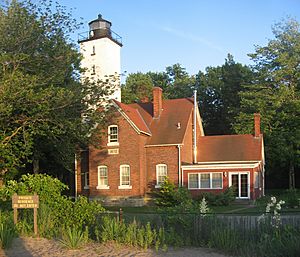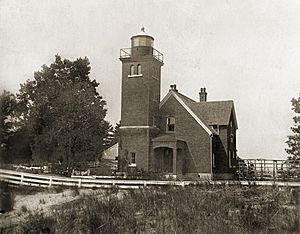Presque Isle Light facts for kids
 |
|
|
|
|
| Location | Presque Isle State Park Erie, Pennsylvania United States |
|---|---|
| Coordinates | 42°9′56.8″N 80°6′55.5″W / 42.165778°N 80.115417°W |
| Year first constructed | 1873 |
| Automated | 1962 |
| Construction | Brick |
| Tower shape | Square |
| Markings / pattern | Solid white |
| Height | 68 ft (21 m) |
| Focal height | 73 ft (22 m) |
| Original lens | 4th-order Fresnel |
| Range | 15 nmi (17 mi; 28 km) |
| Characteristic | Iso W 6s |
| ARLHS number | USA-666 |
| USCG number | 7-3690 |
The Presque Isle Light is a famous lighthouse located on the shore of Lake Erie in Pennsylvania. People used to call it the "Flash Light." It is one of three lighthouses in Erie. The others are the Erie Land Light and the North Pier Light. This lighthouse stands on the northern side of Presque Isle State Park, right by the beach.
The Presque Isle Light first opened in 1873. It was later added to the National Register of Historic Places in 1983. This means it is an important historical building.
Contents
How the Lighthouse Looks
The Presque Isle Light stands 68 feet (21 m) tall. Its light shines from a height of 73 feet (22 m) above the ground. When it was first built, the tower was only 40 feet (12 m) tall. It was made taller later on.
The Lighthouse Beam
The light from the tower shines white for 3 seconds, then turns off for 3 seconds. This pattern repeats. It is called an "isophase light." You can see this light from up to 15 nautical miles (17 mi; 28 km) away. Until 2013, there was a backup light below the main one. This backup light would flash if the main light stopped working. Around that time, the main light was updated. It now uses a modern LED light.
The Keeper's Home
The lighthouse tower is connected to a house. This house has four bedrooms and was where the lighthouse keeper lived. The oil used to power the light was stored in a room at the bottom of the tower. For safety, most of the fuel was kept in a separate shed. After the lighthouse became electric, this oil room was used to store batteries.
History of the Presque Isle Light
In 1789, the United States Congress decided to build and take care of lighthouses. These lights helped ships navigate the nation's waters. The first two U.S. lighthouses on the Great Lakes were finished in 1818. One was in Buffalo, New York, and the other was the Erie Land Light in Erie.
The land where the Presque Isle Light stands was given to the government in 1871. It was meant for national defense and to protect Erie's harbor. By this time, the sand on Presque Isle was always moving. This made it hard for sailors to see the Erie Land Light. So, in 1872, Congress approved $15,000 to build a new lighthouse. This new light would be on the north side of Presque Isle.
Building the Lighthouse
Building the lighthouse was not easy. It was hard to get materials to Presque Isle because there were no roads. Sometimes, the peninsula would even become an island. Barges tried to deliver bricks by water, but one sank and lost 6,000 bricks! After that, everything had to be brought by boat to the bay side. Then, workers carried the materials 1.5 miles (2.4 km) to the building site.
The main parts of the lighthouse and the keeper's house were finished by November 1872. Work stopped for the winter and started again in April 1873. The Presque Isle Light was fully completed on July 1, 1873.
First Light and Changes
A special Fresnel lens was put in the tower. The light began shining on July 12, 1873. Charles Waldo, the first keeper, wrote in his log: "This is a new light station and the light will be exhibited for the first time tonight." The lighthouse first showed a steady white light. Every 60 seconds, it would flash red.
In 1882, the lighthouse got new lenses. Its light pattern changed to alternating red and white flashes every 10 seconds. This is why people in Erie started calling it the "Flash Light." The trees around the lighthouse grew tall and blocked the light. So, in 1896, it was decided to make the tower taller. Bricklayers worked for one month, from August to September 1896. They added 17 feet 4 inches (5.3 m) to the tower's height.
Modern Updates
The lighthouse beacon was once lit by a single 150-watt light bulb. Its Fresnel lens made the light very bright and visible up to 18 miles (29 km). In 1962, the old Fresnel lens was removed. A modern aviation beacon took its place. At this time, the light pattern was changed to the "isophase" light we see today.
The Presque Isle Light was added to the National Register of Historic Places in 1983. In 1997, the United States Coast Guard decided they no longer needed to own it. The Pennsylvania Department of Conservation and Natural Resources took over the lighthouse.
Restoring the Lighthouse
In 2014, a group of people who love lighthouses took over the Presque Isle Light. They signed a 35-year lease to restore it. Their plan was to open it as a museum. The lighthouse reopened for tours in the summer of 2015. The goal is to make the lighthouse look like it did in the late 1800s and early 1900s. Some newer parts added in 1989 will be removed.
Lighthouse Keepers and Residents
| Lightkeepers | |
|---|---|
| Charles T. Waldo | 1872–1880 |
| Orrin J. McAllister | 1880 |
| George E. Town | 1880–1883 |
| Clark McCole | 1883–1886 |
| Lewis Vanatta | 1886–1891 |
| Louis Walrose | 1891–1892 |
| Thomas L. Wilkins | 1892–1901 |
| Andrew Shaw | 1901–1927 |
| Frank Huntington | 1927–1944 |
When the Presque Isle Light first opened, its keepers earned $520 a year. They also got to live in the comfortable house attached to the lighthouse.
From 1974 to 1986, the Coast Guard used the lighthouse as extra housing. Their staff and their families lived there. Since the light was automatic, the guards only had to check the beacon during strong electrical storms. The last residents moved out in 1986. The Coast Guard then decided to close the keeper's house. The Pennsylvania Department of Conservation and Natural Resources later housed state park officials there until 2014.



